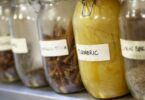Learn how to grow mint indoors.
Mint is a wonderful plant to grow in pots indoors. For optimal development, plants require indirect sunlight and temperatures between 65- and 70-degrees Fahrenheit. Plants should be grown in plastic pots with well-draining growth material kept continuously wet.
Growing Mint Indoors – A Step-by-Step Guide
Choosing the right mint to grow
Any variety of mint may be grown indoors:
- peppermint,
- spearmint,
- pineapple mint,
- chocolate mint,
- and apple mint is all good choices.
Each one has its own distinct flavor as well as a distinct appearance.
Planting and growing mint indoors
Mint is a simple plant to grow and plant inside. Mint may be grown indoors in a pot of soil or even in a bottle of water, depending on the climate.
You’ll need a container with adequate drainage to ensure that your plants grow healthily, for starters. Make a nice container for your mint plant by filling it halfway with a decent potting mix, either a typical commercial variety or one that has equal parts sand, peat, and perlite.
After planting, water the mint plant thoroughly and position it in a location with indirect light, such as an east-facing window in the spring and summer and west or south-facing window in the fall and winter. You should also place your mint plant in a location with an interior temperature of 65 to 70 degrees Fahrenheit (18-21 degrees Celsius) during the day and 55 to 60 degrees Fahrenheit (13-15 degrees Celsius) at night.
If you wish to grow mint indoors in water, take tip cuttings of about six inches (13-15 cm.) in length from a well-established mint plant. Remove the bottom leaves and put the cuttings in a glass or container filled with water. Place it in a bright window that gets at least four to six hours of light every day.
Watering your mint plant
When learning how to grow mint indoors, one of the easiest considerations is how much water to give the plants. In contrast to several other herbs and houseplants, mint is not a demanding plant. Yes, it is possible to over-or under-water it, but neither is simple to accomplish.
Mint is tolerant of both “wet feet” and dry soils, and it grows well in containers. However, you need to maintain a healthy balance between the two. You should only water the plant when the soil feels dry to the touch, and the earth is light in the container.
Indoor mint plants should be watered by moving the pot to a sink or bathtub, turning on the water, and letting it flush through the soil and out the drainage hole located at the bottom of the pot. You should run water through the pot three or four times, allowing it to drain completely before returning the potted mint to its original location on the ledge.
Fertilizing mint indoors
When it comes to cultivating mint indoors, this is another simple task. Fertilize your indoor mint plant with a liquid organic fertilizer every three weeks, from mid-spring to late summer. It should be mixed according to the directions found on the label.
Fertilize once every six weeks from early fall to early spring if you expect to harvest from your plant all winter. Indoor mint, unlike most houseplants, will continue to thrive throughout the winter; therefore, feeding it is a smart idea. Just be careful not to overdo it.
Pruning indoor mint plants
To maintain your mint plant bushy and stimulate new development, give it a regular pruning. Trim the stems back with herb scissors or needle-nose pruners regularly, ideally once every few weeks. Cut slightly above a pair of leaves, and two new stems will sprout from the leaf nodes, causing each stem to branch in half.
Harvesting mint
Harvesting your indoor mint plants is as simple as removing individual leaves as needed or clipping whole stems for drying or fresh use. Make no apprehensions about pruning the plant back to its original size several times a year. This promotes the formation of delicious new growth and the development of a bushy growth habit.
SEE ALSO: 3 Easy Methods for Drying Mint Leaves for Tea
Most plants are normally pruned back to the ground in the middle of the growing season. Within a few weeks, the manufacture of all new deep green and delicious leaves is compelled to commence. It revitalizes the plant just as it is about to enter its phase of most vigorous development.
Thank you for an amazing mint image.






[…] How to Grow Mint Indoors – A Step-by-Step Guide […]